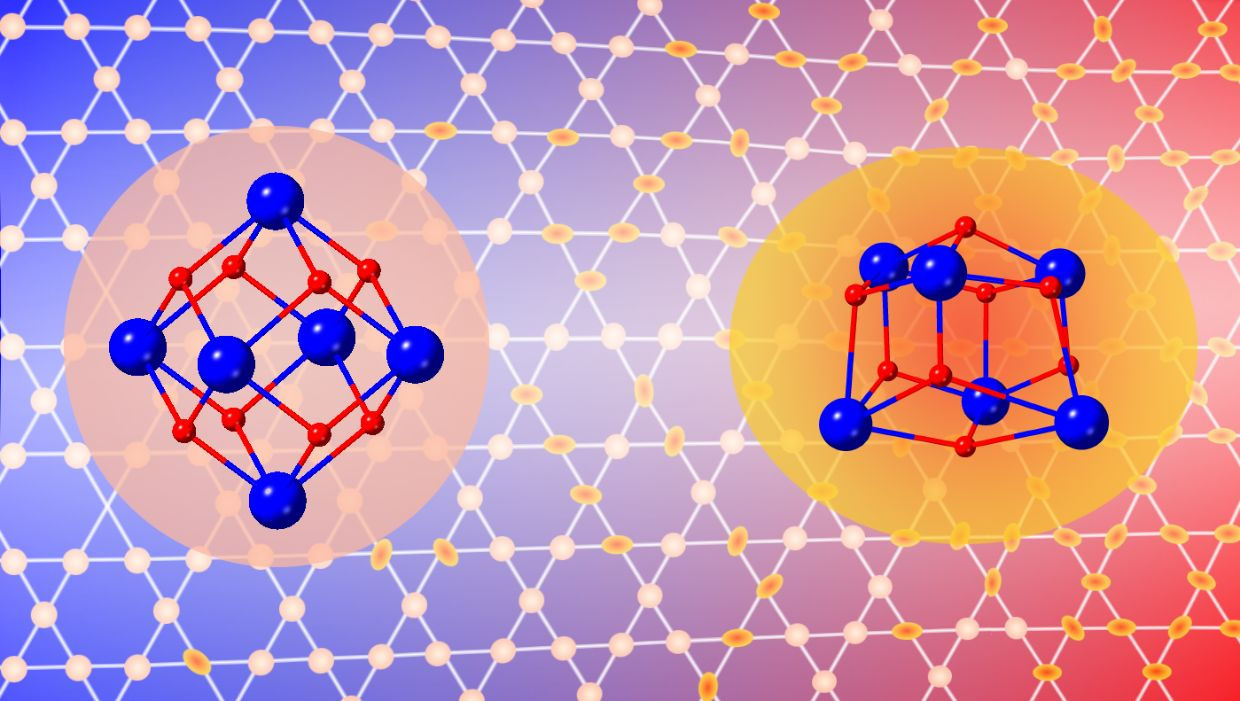
While most solids expand when heated, some exceptional compounds actually shrink as their temperatures rise. This unusual contraction is called negative thermal expansion (NTE). Such counter-intuitive shrinking can occur in crystalline compounds called metal-organic frameworks (MOFs). In general. these materials consist of a network of metallic nodes connected to organic linkers forming a porous extended structure, which can be used for a wide range of applications, such as gas storage or catalysis for gas purification or fuel cells. The control over the thermal expansion properties is important for many applications.
Recently a new mechanism to understand and tune the negative thermal expansion in MOFs was proposed. To test this hypothesis, researchers performed synchrotron X-ray scattering on several variants of a zirconium-based MOF to study the local order of the distorted nodes as well as the long-range order of the overall framework. The scattering experiments were performed at the high-energy X-ray beamline 11-ID-B of the Advanced Photon Source (APS), a U.S. Department of Energy (DOE) Office of Science user facility at DOE’s Argonne National Laboratory. Total scattering data were used to perform the analysis of the pair distribution function (PDF) of the atomic structure. The experimental data indicated that distortions in the nodes (Fig. 1) of the MOF variants greatly affected their thermal behavior. Moreover, increasing the number of distorted nodes correlated to greater MOF contraction.
These results provide scientists a new pathway for controlling negative thermal expansion in metal-organic frameworks and should ultimately lead to new thermal materials that are tailored to particular temperature environments. The researchers also note that MOFs show potential as catalytic materials (compounds that accelerate chemical reactions) and that node distortion may provide a novel approach for enhancing the catalytic performance of MOFs.
MOFs consist of complex crystalline lattices formed from disparate molecular species. The fundamental building blocks of an MOF consist of identical metal ions, or clusters of ions, called nodes. These nodes are connected to one another through a web of organic molecules called linkers. The overall MOF structure consists of innumerable node-and-linker units in a crystalline latticework that features many pores and cavities (Figs. 2a and 2b).

A question naturally arises as to whether the mechanism(s) responsible for negative thermal expansion are the same in both MOFs and simpler compounds. To resolve this question, the researchers examined five variants of NU-1000, a zirconium-based MOF.
Synchrotron X-ray scattering probed structural changes in the five variants as their temperatures cycled from 100 to 250 degrees Celsius. The X-ray scattering data were then processed using methods such as pair distribution function (PDF) and powder X-ray diffraction (PXRD) analysis. The results revealed both short- and long-range structural changes in the MOF samples.
The way each NU-1000 variant changed structurally as it was heated and cooled varied considerably. At around 170 degrees Celsius, the NU-1000-formate variant contracted nearly twice as quickly as the NU-1000-acac variant; by contrast NU-1000-Facac hardly shrank at all. A correlation analysis of the data revealed that the progressive shrinking of the MOFs corresponded to increasing numbers of distorted nodes. Generally speaking, the more distorted nodes that arise in an MOF during heating the more it will shrink.
The experimental results highlight a new avenue for rational control of negative thermal expansion in MOFs. The results also demonstrate that the origin of shrinking in MOFs is quite different than in simpler compounds.
– Philip Koth
____________________________________________________________________________________________
See: Z. Chen1, G. Stroscio2, J. Liu3, Z. Lu3,4, J.T. Hupp3, L. Gagliardi2, K. W. Chapman1, “Node Distortion as a Tunable Mechanism for Negative Thermal Expansion of Organic Frameworks,” J. Am. Chem. Soc. 2023, 145, 1, 268–276 (December 20, 2022)
Author affiliations: 1Stony Brook University; 2University of Chicago; 3Northwestern University; 4Nanjing Tech University
This work was initially supported as part of Inorganometallic Catalyst Design Center, an Energy Frontier Research Center (EFRC) funded by the U.S. Department of Energy, Office of Science, Basic Energy Sciences (DE-SC0012702), and subsequently as part of the Catalyst Design for Decarbonization Center EFRC (DE-SC0023383). This research used resources of the Advanced Photon Source, a U.S. Department of Energy (DOE) Office of Science User Facility operated for the DOE Office of Science by Argonne National Laboratory under contract no. DE-AC02-06CH11357.
Argonne National Laboratory seeks solutions to pressing national problems in science and technology. The nation's first national laboratory, Argonne conducts leading-edge basic and applied scientific research in virtually every scientific discipline. Argonne researchers work closely with researchers from hundreds of companies, universities, and federal, state and municipal agencies to help them solve their specific problems, advance America's scientific leadership and prepare the nation for a better future. With employees from more than 60 nations, Argonne is managed by UChicago Argonne, LLC, for the U.S. DOE Office of Science.
The U.S. Department of Energy's Office of Science is the single largest supporter of basic research in the physical sciences in the United States and is working to address some of the most pressing challenges of our time. For more information, visit the Office of Science website.
